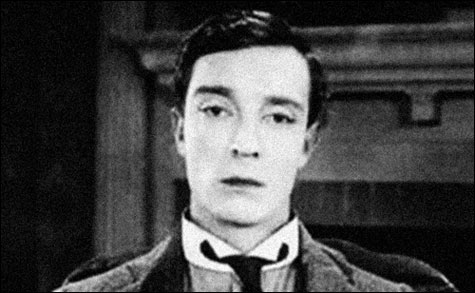
ICONIC COMIC Buster Keaton strikes a doleful pose. |
In his time — the silent film era — he was more popular than Charlie Chaplin. Buster Keaton: Fade to Black does a fascinating job making clear to us why that was so, as Daydream Theatre Company presents it at Bell Street Chapel through April 16.
Such a clever clown. Courageous or foolhardy in his signature stunts, your choice. Stone-faced under a porkpie hat, his hapless screen character survived mishaps and adventures protected only by innocence and blind luck.
Written by Lenny Schwartz with deft imagination and directed by him, this is not the usual straight-ahead biography, though it does proceed chronologically. Incidents unfold in Keaton’s imagination, as he struggles to dictate his preferred versions of events and acknowledge occur-rences he can’t deny. Sometimes other characters argue with him about his accuracy or push him to recall while he would prefer not to, which allows time compression and summaries more dynamic than the usual narrator’s commentary.
Inevitably, Keaton’s comedy was physical. Born into a vaudeville family, at three years old he played the misbehaving boy as his father tossed him around the stage like a rag doll. Joseph Frank Keaton got his nickname at 18 months, he always claimed, after he tumbled down a long flight of stairs and shook it off; whereupon Harry Houdini, witnessing that, remarked, “That was a real buster!”
Jamie Dufault does a fine job as Keaton, establishing a quietly thoughtful presence for the man even when he’s not speaking. Keaton’s unconventional way of thinking is established right away, when on a film set he becomes fascinated with the camera and borrows it to take apart. The camera belongs to silent film star Roscoe “Fatty” Arbuckle (Ed Higgins), and Keaton becomes his straight man, getting knocked about for laughs once again.
Much is made of the pain Keaton learns to go through — not just the constant battering of his body, but emotional assaults. He is virtually illiterate in this portrayal, and his inferiority complex is alleviated only briefly by his 1921 marriage to a script girl, Natalie Talmadge (Sarah Bedard), who eventually thinks as poorly of him as he does.
On the stage here, he has a glass of whisky in his hand almost as often as not, and his self-destructive drinking continues even after he marries his nurse, Mae Scriven (Michelle Snyder) during a blackout binge. Things get so bad that he ends up in a sanitarium, wrapped in a straitjacket, although Houdini had taught him how to get out of it. Not until he marries Eleanor Norris (Lauren Ustaszewski), who was half his age, does he dry out for good.
Keaton would do anything to get a thrill on celluloid. “If I cough up any bones, just pile them in the corner,” he says early on before one tumultuous bout. He wasn’t afraid of risking his life. After all, he was spread-legged between two traveling cars in One Week, promptly carried off by a motorcycle speeding in the opposite direction.
Of course, his most death-defying stunt was in the 1928 Steamboat Bill, Jr., where he had to find his mark precisely, because the front of a two-story house was going to fall his way, an empty window opening passing around him.